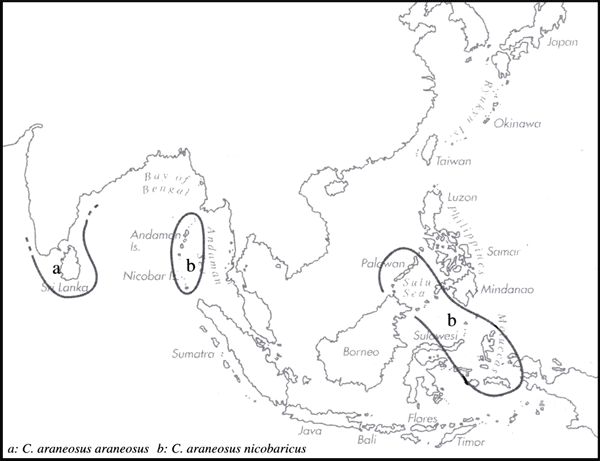
Skip Navigation Links
View access keys for this site.

Range: C. a. araneosus: Sri Lanka and S.E. India. C. a. nicobaricus: Moluccas to Philippines; probably also in Nicobar and Andaman Islands.
Description: Moderately large to large, solid to heavy. Last whorl conical, generally broader in C. a. araneosus (Pl. 2, Figs. 9-12); outline straight to slightly convex. Shoulder angulate, weakly to strongly tuberculate. Spire of low to moderate height, consistently low in C. a. nicobaricus (Pl. 3, Figs. 13-15); outline straight. Postnuclear spire whorls tuberculate. Later teleoconch sutural ramps concave and nearly smooth. Last whorl with weak spiral ribs above base.
| Shell Morphometry | ||
|---|---|---|
| L | 55-100 mm | |
| RW | 0.40-1.50 g/mm | |
| RD | 0.61-0.70 | |
| (C. a. araneosus; 0.61-0.70; -C. a. nicobaricus 0.54-0.63) | ||
| PMD | 0.86-0.94 | |
| RSH | 0.09-0.15 | |
| (C. a. araneosus; C. a. nicobaricus 0.04-0.09) | ||
C. a. araneosus: Ground colour white, tinged with violet in shells from India. Last whorl with a fine network of reddish brown lines outlining small white tents, usually with a dark brown spiral band on each side of centre. Bands interrupted by bluish ground-colour tents and a few brown tents. Teleoconch sutural ramps with fine reddish brown zigzag lines and bluish brown marginal blotches between tubercles. Aperture nearly white (shells from Sri Lanka) or outer part pale violet, interior deep yellow (shells from southeast India, Pl. 2 Fig. 12). C. a. nicobaricus: Ground colour white, occasionally with a tinge of red or violet. Last whorl with a network of reddish brown to blackish brown lines outlining variously sized white tents that often coalesce. Usually with 3 discontinuous bluish or blackish brown spiral bands, on both sides of centre and below shoulder; central band more pronounced than other bands. Spire and shoulder with fine, dark brown zigzag lines and blue-tinged brown blotches between tubercles. Aperture white to light violet, yellow deeper within. Periostracum cream to brown, thin, translucent, smooth.
Periostracum yellow, thin, translucent, smooth.
C. a. araneosus: Foot buff; side and dorsum mottled with brown and with a black longitudinal line continued as a broad band around the anterior dorsum; anterior edge of sole yellow. Rostrum buff; tentacles buff, anterior margins grey. Tip of siphon orange, followed proximally by a narrow white stripe, broad grey stripe and broad stripe of buff heavily mottled with reddish brown (Kohn, 1978). C. a. nicobaricus: Foot buff, paler and with a bilobate black blotch on anterior part of dorsum; sole with irregular transverse and longitudinal brown lines, posterior half darker and anterior edge yellow. Siphon tipped with yellow, then banded with white, black, yellow and dark brown (Kohn, unpubl. observ.).
Radular teeth long and narrow, with one barb and a long, fine serration terminating in a distinct backward- pointing cusp at centre of shaft or somewhat posterior to it (Bergh, 1895). According to Nybakken (1990), radular teeth less elongate, serrations shorter, shaft with waist base with a spur; adapical armature consisting of a barb opposite a blade.
Habitat and Habits: C. a. araneosus: Intertidal to 20 m, on limestone and sandy substrata. C. a. araneosus appears to feed on gastropods (Kohn, 1978a). The egg mass consists of several layers of capsules, each containing 63-214 eggs about 490 ┬Ám in diameter. The larvae hatch at a stage that "swims and crawls" (= veliconcha; Natarajan, 1957). C. a. nicobaricus: Shallow water, on sand substrate under corals and in coral rubble on subtidal reef platforms. Radular tooth structure as given by Nybakken (1990; pers. comm.,1993) indicates vermivory, while that given by Bergh (1895) rather suggests molluscivory.
Discussion: C. araneosus resembles C. bandanus in shape, but the latter species attains larger size (to 150 mm). Its last whorl colour pattern is a much coarser network and has many fewer white tents. We consider C. a. araneosus and C. a. nicobaricus as subspecies, because they are nearly indistinguishable in shell characters and colouration of the animal. C. a. nicobaricus usually has a relatively narrower last whorl and larger shoulder tubercules, and it tends to have a slightly lower spire and coarser colour pattern.

C. araneosus Range Map
This section contains verbatim reproductions of the accounts of 316 species of Conus from the Indo-Pacific region, from Manual of the Living Conidae, by R÷ckel, Korn and Kohn (1995). They are reproduced with the kind permission of the present publisher, Conchbooks.
All plates and figures referred to in the text are also in R÷ckel, Korn & Kohn, 1995. Manual of the Living Conidae Vol. 1: Indo-Pacific Region.
The range maps have been modified so that each species account has it own map, rather than one map that showed the ranges of several species in the original work. This was necessary because each species account is on a separate page on the website and not confined to the order of accounts in the book.
Return to framed version (returns to search page)